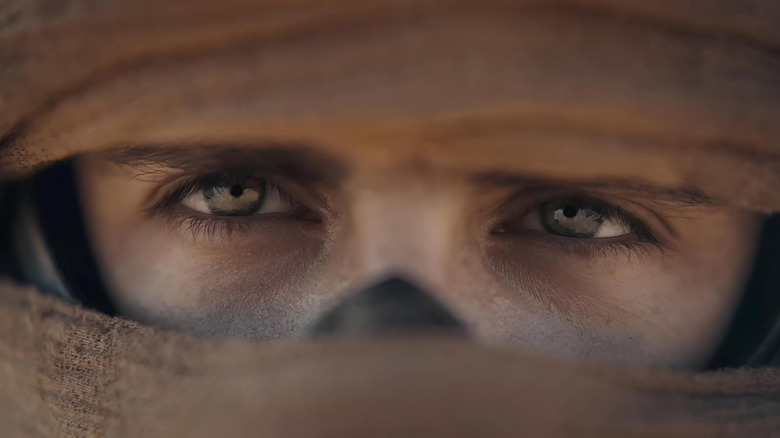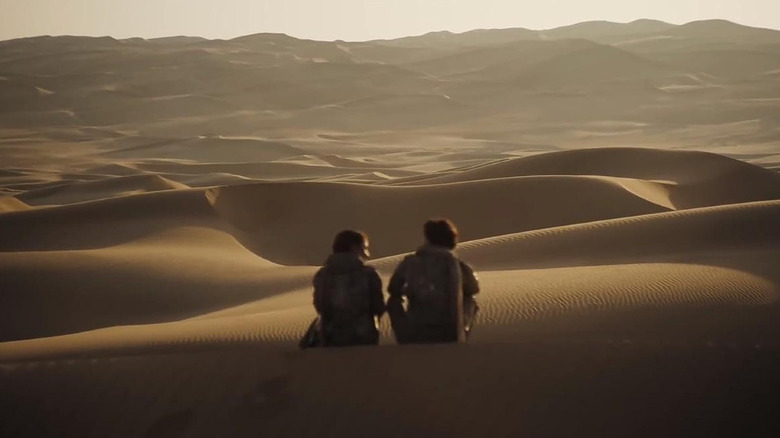Creating Arrakis For Dune 2 Left Director Denis Villeneuve 'Sand-Traumatized'
As much as we here at /Film like to climb up on our soapboxes and carry on about the limits of The Volume and the StageCraft technology (which generate virtual settings using LED video walls), we also get why filmmakers have been flocking to use them in recent years. When you shoot outside on-location, you're inevitably subject to the whims of the natural environment. That means, for example, having to spend hours waiting for rainstorms or a cloudy sky to clear up just so you can get the precise lighting you need for a scene. It's even worse if you're filming in the desert. All it takes is a huge sandstorm to swoop in, and you may find yourself having to rebuild most of your sets.
Shooting in the desert can present other complications too, as director Denis Villeneuve discovered while bringing the desert world of Arrakis to life for "Dune." Because the green from green screens reflected off the sandy surfaces of places like Wadi Rum, Jordan (which was used to portray the war-torn planet on screen), Villeneuve and his crew relied upon beige-colored fabric or "sand screens" to make it easier to add CGI elements to the film during post-production. But with most of "Dune: Part Two" taking place deep within the vast, unconquered Arrakis desert, that meant Villeneuve, his returning cinematographer Greig Fraser, and his production designer Patrice Vermette had to spend even more time scouting for the perfect real-life sand dunes to film.
"For my mise-en-scène, I'll want a particular shaped dune. But Greig Fraser, on the other hand, will need that same shape to be in a specific light," Villeneuve told Empire Magazine for its October 2023 issue. "So Patrice spent weeks and weeks casting sand dunes in the desert! We looked like madmen."
'We didn't repeat a single location'
Trudging through the desert for weeks on end will take its toll on you, as Villeneuve learned. "I still find [sand] every morning in my shoes," he said, wincing. "We're sand-traumatized, for sure." (Must ... not ... make ... "Attack of the Clones" ... reference ...)
If Villeneuve thought he was up to his neck in sand on the "Dune" movies, that was nothing compared to Vermette. The latter told Empire he spent most of the first "Dune" shoot carrying around bottles of desert grains just to ensure the dunes on Arrakis looked consistent, whether they were filming in Wadi Rum or the Liwa desert in Abu Dhabi. He went on to do the same thing for "Part Two," collecting brand-new samples rather than reusing what he already had. "We didn't repeat a single location," he said. "We found completely fresh spots to tell our story this time around."
All that hard work and sand trauma seems to have paid off, judging by the gorgeous visuals in the trailers for "Dune: Part Two." It also made it easier for Villeneuve and his team to make the film's action feel suitably epic, giving them plenty of space to stage sequences like the all-too-anticipated moment from the original "Dune" book where Paul Atreides (Timothée Chalamet) hangs 10 on a giant sandworm for the first time. The Volume and StageCraft are useful tools, no question about it, but if you're willing and able, it's typically good to shoot as much on-location as possible. Just maybe give your shoes an extra shaking out every morning.
Not even the greed of the Association of Motion Picture and Television Producers can stop Muad'Dib, with "Dune: Part Two" now arriving on March 15, 2024.

